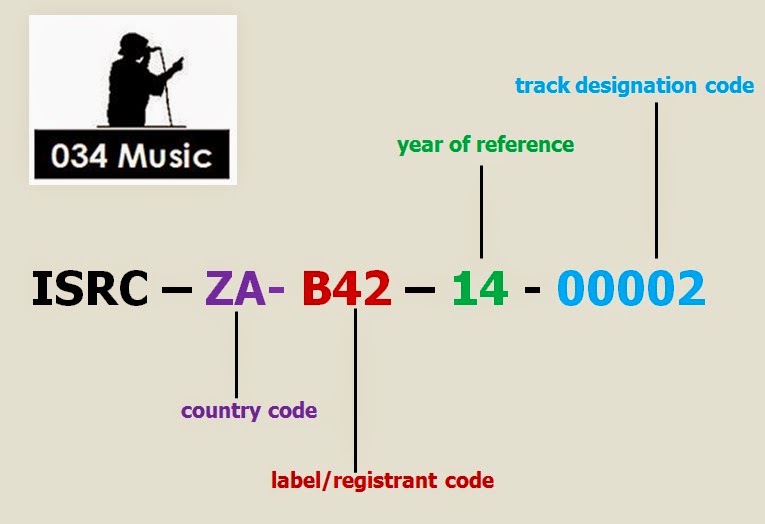By Andile Nkosi
 When dealing Producers of recordings; Digital services and Music Licensing Companies one will come across the acronym ISRC. In this article we discuss these in detail.
When dealing Producers of recordings; Digital services and Music Licensing Companies one will come across the acronym ISRC. In this article we discuss these in detail.
ISRC stands for the International Standard Recording Code and is an international identification system for sound recordings and music video recordings. Each ISRC is a unique and permanent identifier for a specific recording, which can be permanently encoded into a product as its digital fingerprint. Encoded ISRC can provide the means to automatically identify recordings for royalty payments. Moreover, ISRC helps to avoid ambiguity of recordings and simplifies the management of rights when recordings are used across different formats, distribution channels or products.
Any new or materially changed recording must be provided with a new ISRC. As previously mentioned once an ISRC is assigned, it remains the same for the lifetime of the recording. An ISRC can be assigned retrospectively too. If a recording was released without an ISRC one should be allocated before it is re-released.
It is important to note that each distinct recording should be assigned its own unique ISRC. If a recording appears at different bit-rates or on different formats the same ISRC is retained. Recordings are considered to be different based on differences in the actual recorded content, such as:
Different versions, for example having differences in playing time
Different mixes/edits
Creating a new surround mix from recorded stems
Restoration of a historical recordings that involves creative input
The general rule is that if the changes being made to the recording involve new artistic input then a new ISRC code is assigned to the resulting recording or version.
ISRCs can also be assigned to:
Promotional material or hidden tracks
Podcasts, radio interviews, audio books and wildlife recordings.
Ring sounds that are digitized audio files
The International Federation of the Phonographic Industry (IFPI) recommends that all music producers use ISRC. Accordingly IFPI appoints an agency in each country to ensure that ISRC is properly administered at a local level. RiSA is the agency for ISRC in South Africa.
Basic ISRC structure
ZA - Country Code — two characters issued by the ISRC Agency. In South Africa this is always ZA
B42 - Registrant Code — a three character alphanumeric code issued by the ISRC Agency. Each production company is assigned its very own registrant code.
14 - Year of Reference — the last two digits of the year in which the ISRC is assigned to the track.
In this case the song was assigned an ISRC in the year 2014. This is allocated by the production company.
00002 - Designation Code — a five digit unique code assigned by the production company. These numbers must not be repeated in the same calendar year.
In this example, the song is the 2nd song to be assigned an ISRC in 2014 for the South African based production company Rabona Music.
How do I encode an ISRC onto a CD?
Compact Disc: The ISRC codes and the relevant point of sale code (such as UPC) should be inserted on the Pre-Master during the mastering process. Speak to the company mastering your music to ensure this is done.
Electronically Distributed Music: Most formats for electronically distributed music allow the inclusion of an ISRC, which can be inserted by authoring software. Where electronically distributed formats include several tracks, the ISRC of each track should be associated with it in the metadata of the file.
MP3: The MP3 format does allow rights management information like ISRC to be included however it is rarely used. What is used is the ID3 system of tags, which is not part of the international standard, but does enable ISRC to be encoded. It is therefore recommended that an ISRC be encoded into the ID3 tag.
Other important factors to note about ISRC are that:
Once assigned, an ISRC must not be re-used under any circumstances
ISRCs can be applied to promotional material such as 30-second clips and hidden tracks particularly if at any time in the future the asset may be separately.
ISRC are assigned to videos as well. If a song exists in audio and in video format, a separate ISRC should be created for the video as well.
Unlike ring tones, ring sounds are digitized audio and should be assigned an ISRC.
How do I apply for an ISRC?
Contact the National ISRC Agency for your territory, In South Africa this is RISA. Elsewhere use IFPI. Alternatively, get your publisher to do this on your behalf.
The bottom line is, if your tracks broadcast on radio or played in public then you need to invest in an ISRC code.





thanx for the info,how long do u think it takes for me to get this code?
ReplyDelete